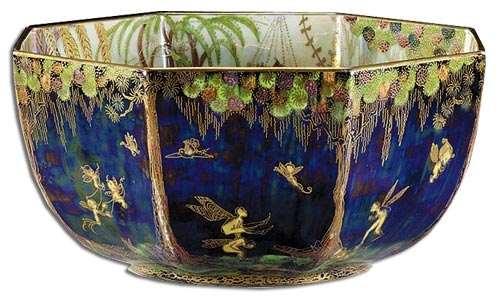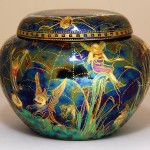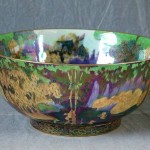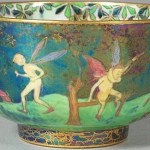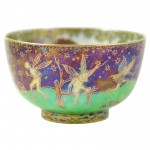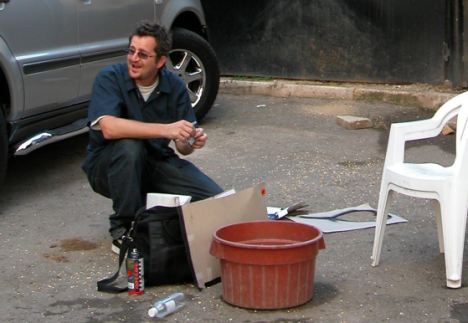One of seven children, Susannah Margaretta ‘Daisy’ Makeig-Jones was born in 1881 in a small mining village near Rotherham, where her father was a GP. From an early age, Daisy showed she had an artistic talent and when her father moved his practice to Torquay, she entered the town’s School of Art. After a short spell at a London school of art, she managed, through a relative, to obtain an introduction to Cecil Wedgwood, at that time managing director of the company. Despite his fears that a doctor’s daughter might find it difficult to adjust to factory life, in 1909 Daisy joined the company as a trainee designer.
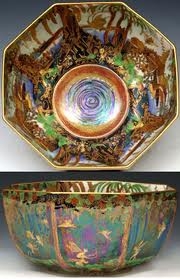 Wedgwood need not have worried. Her art school training helped considerably and by 1914, she was considered good enough to be given her own studio. Fairies bring good luck, they say. Daisy’s run started by being placed in the studio next to the one where trials were being carried out on the new glazes that were to add so much to her inspired designs. There, she was able to watch the painters at work and pass to them watercolour drawings of her Fairyland ideas so that, in effect, they became part of the experimentation.
Wedgwood need not have worried. Her art school training helped considerably and by 1914, she was considered good enough to be given her own studio. Fairies bring good luck, they say. Daisy’s run started by being placed in the studio next to the one where trials were being carried out on the new glazes that were to add so much to her inspired designs. There, she was able to watch the painters at work and pass to them watercolour drawings of her Fairyland ideas so that, in effect, they became part of the experimentation.
Magical ceramic wonderlands created for Wedgwood Fairyland Lustre by Daisy Makeig-Jones. The piece pictured here is a product of her vivid imagination.
The interest in Fairyland Lustre among today’s collectors is, no doubt, fuelled by the urge to own something of such individualistic character. The search could prove long and expensive.
Wedgwood’s rise to prominence in the 18th century was based on innovation in manufacture and designs that, despite being adaptations of classical motifs from the antique, were presented in a new form, which had broad based appeal. However, during the 19th century Wedgwood lacked the innovation and energy provided by its founder Josiah I, and its wares became for the most part derivative, concentrating almost exclusively on production of its traditional basalt and jasper wares.
By the early 20th century, the factory was nearly bankrupt. The key to its survival to a very large extent was the development, in the early 1900s, of a dazzling range of new glazing techniques, particularly one which produced a finish of multi-coloured iridescence.
The catalyst for change at the company’s Etruria works in Stoke-on-Trent was Daisy’s fairies. They were loved by some and hated by others, indeed, some thought she was mad, but without doubt, they helped the company return to profitability after the First World War.
In fact, Daisy subsequently carried out her own test firings with glazes of different colours and lustres that were later adopted when production began – a mere nine months after being taken on as a staff designer. Impact of the ware on the public was phenomenal and all the best shops clamoured to obtain pieces for sale. At first, decoration featured butterflies, dragons, fish, birds and other naturalistic designs in stunning, even garish, colour schemes that were such welcome relief during the drab war years.
However, these earlier pieces should not be confused with true Fairyland Lustre. This first appeared in 1915, by which time Daisy’s imagination was beginning to run riot. Rich blues, purple, orange (her favourite colour) yellow, green and gold, were all worked together with pixies, elves and sprites in ways reminiscent of book illustrations by Edmund Dulac and Arthur Rackham.
Like all clever pictures, the harder you look, the more you see. Elves playing leapfrog; spiders spinning evil webs; gaudy rainbows over romantic castles; ghostly woods and apparitions in the Land of Illusion.
Interestingly, rather than being figments of an over active imagination, many Fairyland designs have strong links with folklore, legend and tradition, though clearly, Daisy’s fairy people did things their way.
Scarcity value plays a part in boosting saleroom prices of Fairyland Lustre. Very little comes on to the market that is likely to fetch less than £200-£300.
However, the ware is also the kind of thing that could go overlooked in the right place – or wrong place, depending on how you look at it! Perhaps the fairies will bring you a little luck at the local jumble sale.

